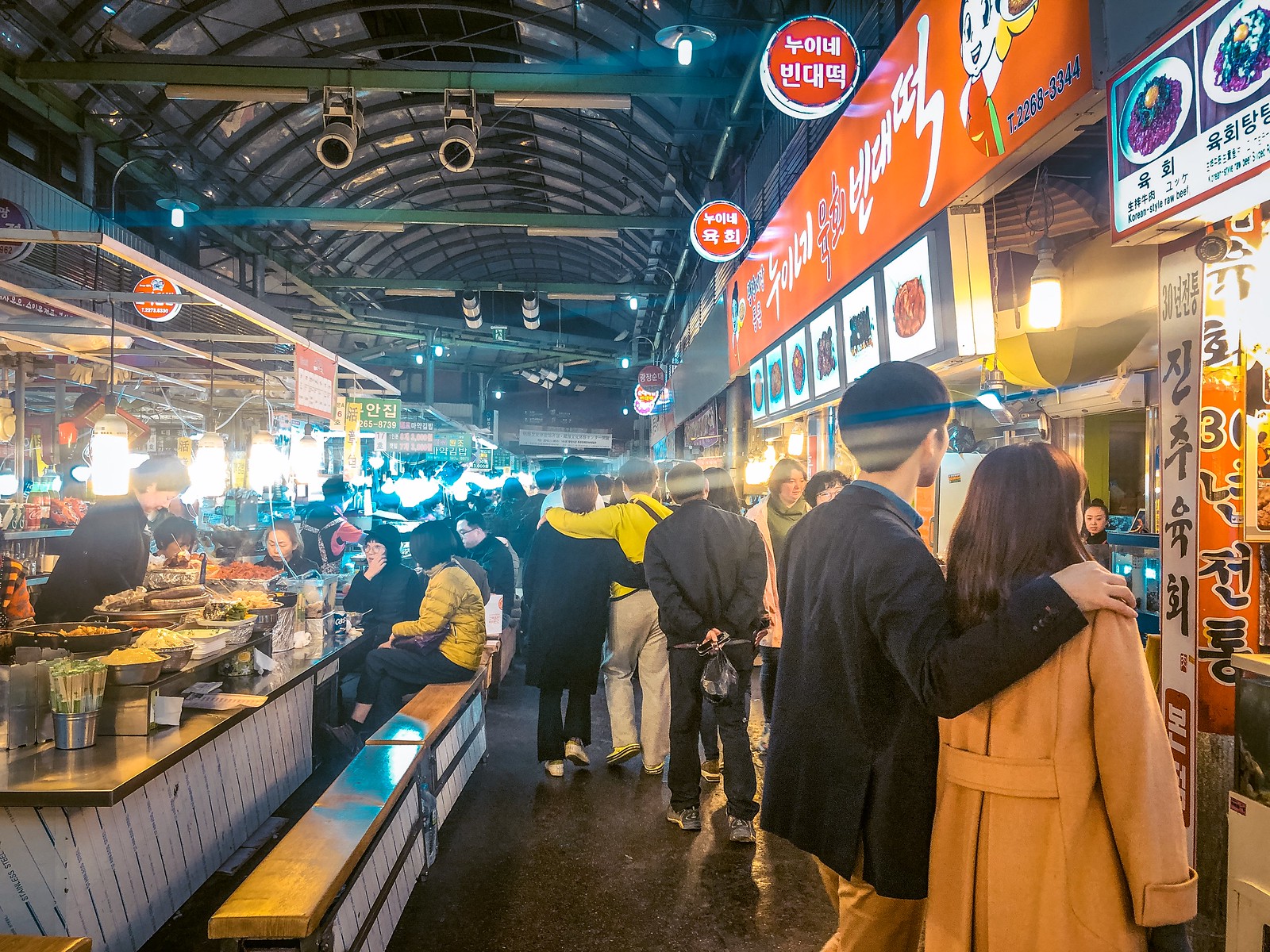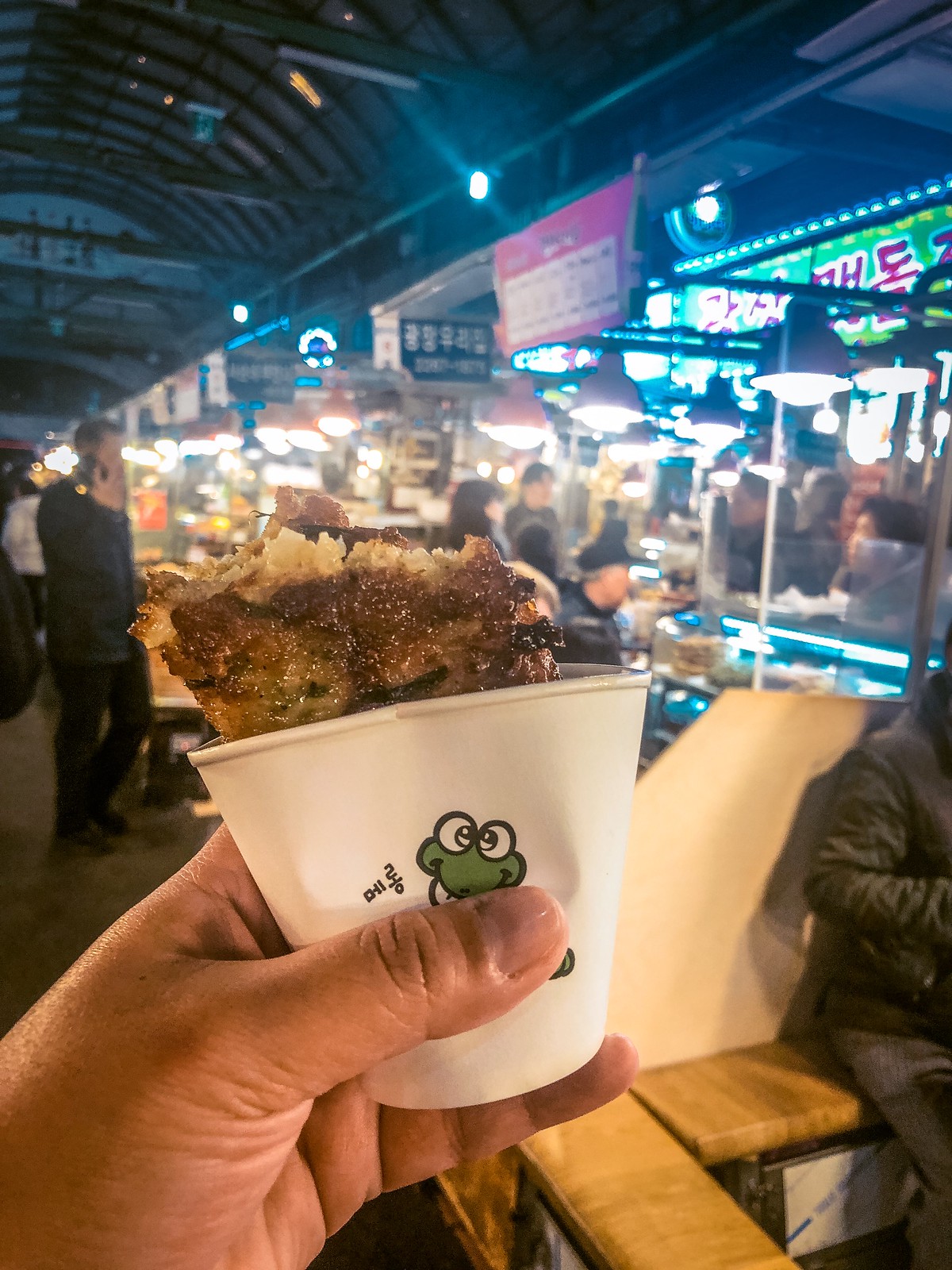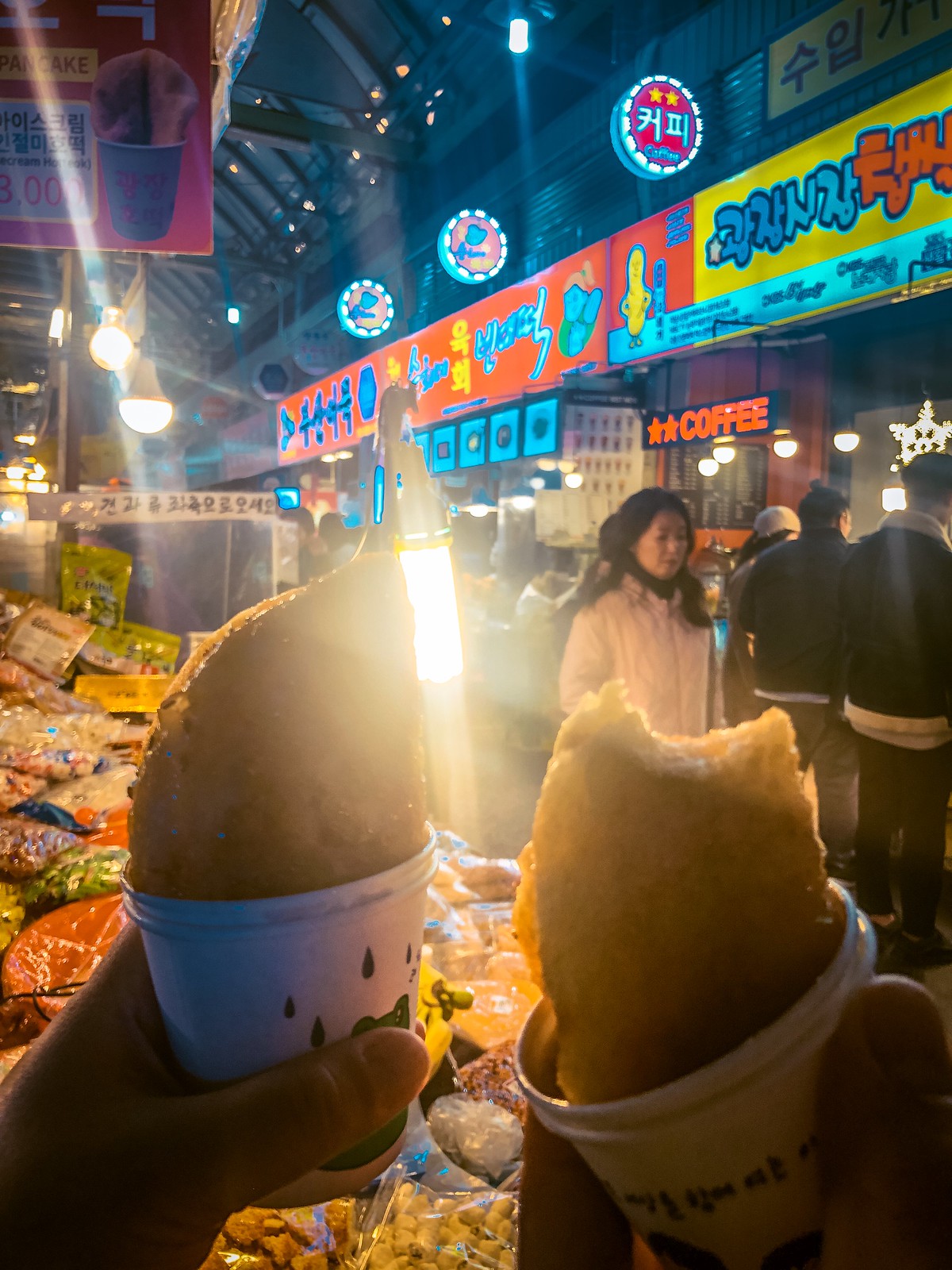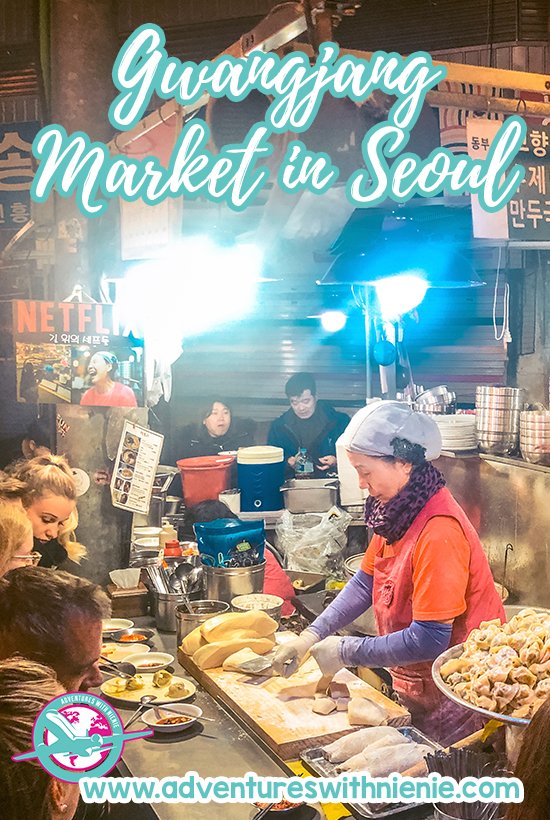Gwangjang Market (광장시장) is a famous Korean street food market located fairly close to the Dongdaemun Design Plaza. This traditional food market offers a variety of traditional Korean street food from Mungbean pancakes, mandu (Korean dumplings), and more. If you want to get traditional Korean food in South Korea, this is the place to do it. If you are new to Korea or just traveling you have to add Gwangjang market to your places to visit at least once in your lifetime.
This site contains affiliate links to products. We may receive a commission for purchases made through these links. Support my blog here.

Gwangjang Market | What to eat in Seoul’s Traditional Market
This market is Seoul’s oldest traditional market to get traditional clothing, traditional street food, and more. Gwangjang Night Market is when most of the action happens, but there are some workers that come in to eat food during the lunch rush. Gwangjang Market is also known as Gwangjang sijang and Kwang jang Market. Kwangjang is the old spelling and sijang just means market in Korean.
Why is Gwangjang Market Popular?
Gwangjang market is a popular Seoul food market because it’s the oldest market in Seoul. It is not only known for its Gwangjang market street food, but you can also get a lot of great clothing items in this area. It is considered to be one of Korea’s largest markets and is located in the heart of Seoul. Here you can find a variety of things from silk, custom-made hanboks, vintage clothing, and traditional Korean street food. If you are looking more for clothes, then I highly suggest visiting Dongdaemun market.
Planning a trip to Korea? Join our Korea Travel Planning + Guide Facebook Group to ask and get answers to all your burning questions.
What to eat at Gwangjang Market | Popular Korean Street Food in Gwangjang market
There are so many great food stalls at Gwangjang Market and it has always been popular among tourists visiting South Korea. However, it has recently become even more popular due to the famous Gwangjang Netflix series on Korean Street Food. If you are planning to visit Gwangjang Market, then these are the Korean street foods you need to try there. I’ve listed Gwangjang market famous food options below.
Unlike the food market Myeongdong, the food at Gwangjang market is more traditional in comparison. Here are some of the most popular things to eat at Gwangjang market.
Not sure what to eat or feel intimidated? Book this Gwangjang Market food tour!

Bindaetteok – Mungbean Pancakes – best food at gwangjang market
Gwangjang market Food is known for these famous and popular mung bean pancakes and all for good reason as well. You will go here and have one and I’m sure you’ll crave another and want to go back. This Gwangjang market pancake reminds me of potato pancakes and are warm and a little crispy on the outside. It’s absolutely delicious and a must eat at Gwangjang market.
Kimbap or Gimbap
This popular Korean dish is best described as a Korean version of sushi. However, instead of raw fish, this dish is usually stuffed with vegetables and meat including carrots, cucumbers, pickled radishes, and meats like bulgogi (marinated beef), tuna, and more. You can get a variety of different types of kimbap, although the smaller or mini ones called Mayak kimbap also spelled Mayak gimbap are considered to be more favorable in this market.
Kalguksu
This Gwangjang market kalguksu traditional Korean soup is filled with knife-cut Korean-style noodles. This soup is great for keeping you warm during the cold winter months and packed with comfort and flavor. There are different types of Kalguksu you can get from seafood to beef.
This soup is mild in flavor meaning it isn’t spicy however like most Korean dishes is often served with a side of kimchi. If you plan to go visit the Gwangjang Market Netflix lady, this is one of her most popular dishes and one of the most popular knife-cut noodles att Gwangjang market – she is known as the Netflix kalguksu lady.

Mandu
There are two typical types of mandu or dumplings that are typical in Korea. There is the traditional flavor filled with minced meat and veggies and the kimchi mandu which is filled with mean and kimchi. Kimchi mandu is only common in Korea and it’s one of my favorites to eat in Korea. They are so delicious and you can’t leave this market without eating them.
Most Koreans eat it steamed or in a soup, however, there are places that pan-fry them. I usually like them panfried, however, it honestly depends on how they are made and what they are stuffed with. The woman from the Netflix stand has both the traditional and kimchi mandu and let me tell you, that kimchi mandu is something I want to go back for.
떡볶이 – Tteokbokki
This is a popular Korean street food at Gwangjang market that is made of cylinder-shaped rice cakes and covered in a sweet and spicy sauce. You can see this type of street food all over South Korea and it’s one of the most popular street foods to enjoy. If you haven’t had it or found other vendors in other locations, be sure to have some here.
육회 – Yuk-hoe or Steak Tartare
This market is very popular for the steak tartare. They usually top it off with a raw yellow yolk that you mix in with the steak tartare. Although I didn’t get a chance to try it here because I was so full off of everything else, it looked absolutely delicious and I plan to go back and have some. I really enjoy beef tartare in South Korea because it is so flavorful and lightly seasoned.
Soondae
Best known as blood sausages. This dish is for the adventurous because it is a bit chewy in texture and blood sausages are usually stuffed pig intestines. They are quite delicious but can be somewhat bland as well. I think the texture is what most people dislike about it.
Sannakji
Although you can get live octopus here, I would suggest you wait and get it at one of the fish markets in Seoul or Jagalchi market in Busan. If you don’t have a chance to visit those places, then you could try it here. It’s one of my favorite dishes to eat in South Korea. It’s a freshly cut octopus covered in sesame oil, sesame seeds and a little bit of salt. The octopus is still moving on the plate and you may need to use your chopsticks to pry the moving tentacles, but honestly, don’t let that scare you away.
Soy Marinated Crab
Soy Marinated Crab at Gwangjang Market in Seoul is a must-try delicacy. This dish features crab marinated in a blend of soy sauce, garlic, and a hint of sweetness. The meat is tender, and the roe offers a rich, oceanic flavor. It’s a hands-on eating experience that captures the essence of Korean street food.
Other options you can eat at Gwangjang Market
- 비빔밥 – Bimbimbap – A spicy rice dish with veggies and meat
- 물냉면 – Mul-naengmyeon – Cold noodle soup
- 족발 – Jokbal – Pigs feet
- 닭발 – Dalkbal – Chicken feet
Desserts at Gwangjang Market

Hotteok
This popular street food in Korea and usually served during the winter months. I only found a few stalls at the Gwangjang market that had them, but if you find them it’s totally worth checking out. It’s my favorite dessert street food option in South Korea. A hotteok is a sweet rice flour pancake that is usually stuffed with brown sugar and sometimes sunflower seeds and nuts depending on the vendor.
꽈배기 – Twisted Korean doughnut
Right next to the hotteok stand I saw inside the Gwangjang market was a stall selling Gwabaegi which is a popular Korean doughnut. This is a very popular donut that is made of rice flour so it’s a little stickier than regular donuts. They are usually hot and fresh in order to be good and covered in sugar and sometimes cinnamon sugar. If you are a donut lover like myself, you must try one of these donuts.
붕어빵 – Bungeo-ppang
Now, this is a popular snack among many Asian kids. It was my favorite growing up and if you aren’t a big fan of sweet red beans then I don’t suggest you order this. This is a fish-shaped pastry stuffed with sweetened red bean paste. This popular dish originated in Japan and was brought over and become a popular staple in Korean street food cuisine.
호두과자 – Hodo Kwaja
These delightful treats are made from a soft, cake-like batter that’s poured into a walnut-shaped mold. Inside, you’ll typically find a filling of sweet red bean paste, and sometimes even a chunk of walnut for that extra crunch. The mold is then closed and baked until the outside turns a golden brown. The result? A warm, fluffy pastry with a gooey, sweet center.
Hodo Kwaja is a popular snack not just for tourists but also for locals. It’s like a hug for your taste buds—comforting, sweet, and oh-so-delicious. Plus, they’re usually sold in little paper bags, making them the perfect on-the-go snack as you continue to explore the wonders of Gwangjang Market.
Where to shop at Gwangjang Market
So all of the street food vendors are typically on the first floor. If you want to look for fabrics, clothing, and more, they are mostly on the second floor. There are a few vendors on the first floor down some alleyways as well. I would say that the more prestigious ones are upstairs with higher quality, however, I find them all to be pretty great in design. I highly suggest taking one of Gwangjang Market’s day tours in Seoul to get more out of it.
How to get to Gwangjang Market and Opening Hours
- Gwangjang Market Opening hours: Typically 8:30 am – 6 pm daily but the restaurants are usually 8:30 am to 11:00 pm, but I suggest you go in the afternoon or evening even though places are opening in the morning, most of them are prepping the food for the day. Some places are closed on Sunday.
- Address: 88 Changgyeonggung-ro, Jongno-gu, Seoul, 서울특별시 종로구 창경궁로 88 (예지동)
- How to get there: Take the subway to Jongno-5 station and exit number 7. Head straight and you will see the entrance to the market on your right-hand side.
- Prices: Korean street food prices vary, at the Netflix stall we paid 10,000 won (~$9USD) for a bowl of Kalguksu and Mandu. We shared the dish and it was pretty filling for 2 people. The Bindaetteok was about 2 for 3,000 won (~$2.50). So honestly, it depends on where you go and what you get. Most places are 1,500 won and up.
- Website: www.kwangjangmarket.co.kr
Things to do near Gwangjang Market
There are a lot of things to do near Gwangjang Market. Besides eating foot at Gwangjang market, here are a few things I suggest you do while here.
Purchase a Hanbok
The Hanbok is a traditional Korean dress characterized by its vibrant colors and simple lines. The women’s version usually consists of a jeogori (blouse) and a chima (skirt), while the men’s version has a jeogori and baji (pants). It’s a symbol of Korean culture and heritage, often worn on special occasions and holidays.
Now, why should you buy it at Gwangjang Market? Well, my friend, this market is like a treasure trove for authentic, high-quality Hanboks. Unlike the mass-produced versions you might find elsewhere, the Hanboks here are often handmade, stitched together by artisans who’ve honed their craft over decades. You can feel the love and tradition in every thread. Plus, the variety is astounding—whether you want something traditional or a modern twist, you’ll find it here. And let’s not forget, the prices are often much more reasonable compared to specialty boutiques.
Buy Traditional Souviners
Gwangjang Market is like a treasure chest when it comes to traditional Korean souvenirs. Let’s go on a little virtual shopping spree, shall we?
- Korean Pottery: Whether it’s a celadon vase or a cute kimchi pot, Korean pottery is renowned for its craftsmanship. These make for elegant gifts or home decor.
- Korean Fans: Hand-painted with intricate designs, these fans are not just functional but also incredibly beautiful. They’re easy to pack and make for a charming gift.
- Traditional Masks: Known as “Hahoe,” these masks are often used in traditional Korean plays and dances. They make for unique wall decorations and are a great conversation starter.
- Korean Tea Sets: If you’re a tea lover, you’ll adore the traditional Korean tea sets. They often come with a teapot, cups, and a serving tray, all exquisitely designed.
- Korean Snacks: From dried seaweed to honey-filled “Yakgwa” cookies, Korean snacks are a tasty souvenir that won’t last long but will be remembered!
- Calligraphy Sets: If you’re into art or writing, a traditional Korean calligraphy set could be a meaningful keepsake. It usually includes brushes, ink, and paper—all you need to try your hand at this ancient art form.
- Jewelry: You can find beautiful pieces made of jade, a stone that holds special significance in Korean culture. It’s said to bring good luck and prosperity.
- Silk Scarves: These are often hand-painted and feature traditional Korean patterns. They’re lightweight, making them easy to pack, and they add a touch of elegance to any outfit.
- Korean Ginseng: Known for its health benefits, Korean ginseng is a popular gift. You can find it in various forms, from roots to extracts and teas.
Gwangjang Market FAQs
Is Gwangjang market indoors?
It is not located indoors, however, it is under a covered structure. It’s a large open space with roofing which prevents rain and other weather from ruining your chances of eating at this vintage market in Seoul.
Where is Gwangjang market located?
It’s located in Seoul, South Korea. The address is 88 Changgyeonggung-ro, Jongno-gu, Seoul, 서울특별시 종로구 창경궁로 88 (예지동).
Does Gwangjang market take card?
Not typically. This Korean food market in Seoul is pretty much a cash-heavy area to grab cheap and delicious food. Myeongdong food market is pretty much the same as well.
What is the kimbap Korean spelling?
김밥 is the Korean spelling for Gimbap or Kimbap.
What are the best food in Gwangjang Market?
I’ve listed them above, but to be short and concise, the top choices are binddatteok, kimbap specifically mayak kimbap, Kalguksu, mandu, 떡볶이 – Tteokbokki, 육회 – Yuk-hoe or Steak Tartare, Soondae, Sannakji, 비빔밥 – Bimbimbap – A spicy rice dish with veggies and meat, 물냉면 – Mul-naengmyeon – Cold noodle soup, 족발 – Jokbal – Pigs feet, 닭발 – Dalkbal – Chicken feet, Hotteok, 꽈배기 – Twisted Korean doughnut, and 붕어빵 – Bungeo-ppang.
What are some halal food at Gwangjang market?
While I can’t guarantee any of the meat is halal, here are some halal options you can consider: Gohyang Kalguksu, hotteok, 꽈배기 – Twisted Korean doughnut, 붕어빵 – Bungeo-ppang, 떡볶이 – Tteokbokki, some mayak kimbap, and 물냉면 – Mul-naengmyeon – Cold noodle soup.
How to go to Gwangjang market by subway
Take the subway to Jongno-5 station and exit number 7. Head straight and you will see the entrance to the market on your right-hand side.
Did you like this article? Support this blog by donating to the button below.




